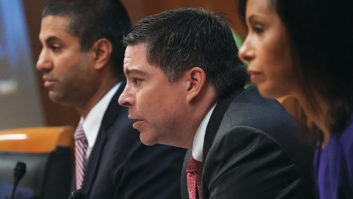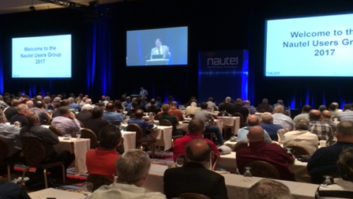LAS VEGAS � FCC Chairman Ajit Pai delivered his first NAB Show�keynote address as chairman on Tuesday. The chairman talked basketball, incentive auctions, AM revitalization (of course) and more.
Following his speech, the FCC released the full text of his remarks, which we are sharing below.
***�
Thank you, Sen. Smith, for that warm introduction and for your outstanding leadership.
I have a confession to make. After the Oregon Ducks beat the Kansas Jayhawks in this year�s Elite Eight, I briefly considered turning down Sen. Smith�s invitation to address the NAB Show. But then I quickly remembered that the Chairman of our congressional oversight committee, Greg Walden, is a University of Oregon graduate (not to mention a former broadcaster). So here I am.
This morning is my first time speaking at an NAB Show general session. After four years of smaller panel discussions, this is a big change. �In television terms, it�s kind of like being moved from an early-morning time slot to primetime. And with this step up comes added pressure. After all, I don�t want to be like ABC�s �Emily�s Reasons Why Not� or CBS�s �Secret Talents of the Stars� and get cancelled after just one episode!
But on a more serious note, this is a time of exciting opportunities and daunting challenges for all segments of the communications industry. Things are changing quickly and at an ever-faster pace. So if you�re standing still, you�re falling behind.
This is certainly true for broadcasters, as NAB recognizes. �The central theme of this year�s show is that the convergence of Media, Entertainment, and Technology � the M.E.T. Effect � has created a new digital economy, and with it, new challenges, new sources of competition, and new opportunities for the broadcasting industry.
It�s clearer than ever that the way Americans produce and consume media today is dramatically different than it was a generation ago. Indeed, as the father of a five-year-old and a three-year-old, I see this every single day. When I was growing up, Sesame Street was a show that you watched on a television set at the same time each day. To my children, Sesame Street is a collection of videos and apps that they can interact with on numerous devices whenever they want.
�
But notwithstanding these changes, I remain fundamentally optimistic about the future of broadcasting. �For starters, there is abundant evidence that broadcasters are continuing to thrive in the Internet age. The overwhelming majority of the most watched shows are still on broadcast TV. �And each week, 93% of Americans over the age of 12 listen to the radio, which is about the same as a decade ago, and the decade before that, and the decade before that.
But the biggest reason I�m bullish about this medium is that broadcasting�s strengths � its values � are timeless. I�m talking about localism, diversity, and public service.
Americans will always need people in their communities to do investigative reporting to keep local leaders honest.
We will always need a universally available platform for people from all walks of life to share their views or their art.
We will always need a trusted source to turn to when disaster strikes and we are desperate for up-to-the-minute information on how and where to seek help.
We will always need shared experiences that connect our communities � whether it�s a show on TV that makes us laugh, a song on the radio that makes us sing along, the wrong winner being announced at an awards show, or a widely-disliked team mounting a dramatic comeback to win the Super Bowl.
That�s why I believe we will always need broadcasters.
Lest you think I�m just up here spraying sunshine, consider Ooyala�s February 2017 State of the Industry forecast which offered a sobering assessment of the hyper-competitive digital video landscape. It found, �Original, local and live are the big three types of [over the top] content that will set services apart in a standing-room-only video marketplace.� But think about that for a moment. �Original, local, and live content is right in broadcasting�s wheelhouse. So continued success is there for the taking.
I want to focus on localism for a minute. The average amount of local news programming aired by commercial television stations has increased by over 40% since 2004. And this didn�t occur because of government mandates. It occurred because broadcasters responded to consumer demand and competitive pressures. �So I don�t see the free market as the enemy of localism. To the contrary, I see them as entirely compatible.
And it�s also important to note that local newscasts can make an impact far beyond the local communities in which they are seen. �For example, here�s one statistic that I found quite striking. Last year, the Pew Research Center asked American adults from which forms of media they had learned about the presidential election in the prior week. And the most common answer was local television news. That�s right. More Americans had learned about the presidential election from local television news than from national television news, cable television news, news websites, social networking websites, or newspapers. I guess that�s why it�s still called BROAD-casting.
So where does the FCC fit into the future of broadcasting? Our job, as with any part of the communications industry, is to make sure that our rules keep up with the times.
The last thing broadcasting � or any industry for that matter � needs is outdated regulations standing in its way. �And that�s particularly true in communications, where things change so quickly. That�s why I�ll work aggressively to modernize the FCC�s rules, cut unnecessary red tape, and give broadcasters more flexibility to serve their audiences. Broadcasting remains an indispensable part of America�s communications landscape. And under my chairmanship, broadcasting won�t be seen as a speed bump.
Here�s how we�re putting these principles into practice.
I�ll start with one of the hot topics at this year�s show: ATSC 3.0, or Next Gen TV, as some call it. There�s a lot of excitement surrounding this new technology � and for good reason. This new transmission standard is the first one to marry the advantages of broadcasting and the internet. And it has the potential to let broadcasters offer much better service in a variety of ways. Improvement in picture quality with 4K transmissions; immersive audio; better accessibility options; the ability to provide advanced emergency alerts, more tailored to a viewer�s particular location. ATSC 3.0 makes all of these possible.
That�s why I made it a priority to tee up the Next Gen TV standard. In my first full month as chairman, the commission voted unanimously to seek comment on a proposal to allow broadcasters to use the ATSC 3.0 transmission standard on a voluntary, market-driven basis.
My view is simple: As with any industry, the FCC should promote innovation in the broadcasting business � not stand in the way of progress. We should allow interested broadcasters to experiment with this next generation standard.
Regarding timeframe, the deadline for submitting input on our proposal is June 8. We�ll then review the record carefully. Our goal is to issue a final authorization of the Next Gen TV standard by the end of the year. We�ll move quickly (by FCC standards, anyway) because I want the United States to lead the world in broadcasting, just as in the communications industry generally.
Next, I�d like to discuss a new initiative that I�m pretty excited about. As you surely know, one of the most powerful forces in government is inertia. Rules that get on the books seem to stay there forever, even when they�re no longer needed or are counterproductive. That�s certainly true when it comes to the FCC�s media regulations. Right now, there are close to one thousand pages of them on the books, many of them decades old.
Well, I�m trying to change that. Given the realities of today�s media marketplace, we need to see which rules are still necessary and which should be relaxed or repealed. So at the FCC�s next public meeting on May 18, we will vote on a proposal to start a comprehensive review of the FCC�s media regulations. �This morning, I circulated the Public Notice to my fellow Commissioners that would kick off this review. We�ll also explore whether certain rules should be modified to provide regulatory relief to small businesses. And to be clear, while our broadcast regulations will be a critical subject of this proceeding, we will also review rules pertaining to cable and direct broadcast satellite.
Now, for this effort to be successful, we�ll need you to participate. We�ll want to hear which rules you think should be modified or repealed as part of this review, and why. �We�ll then study the record to determine whether to propose modifying or eliminating certain regulations. Our goal is simple: to have rules that reflect the world of 2017, not 2007, 1997, 1987 or 1977.
As it stands, there are some outdated rules that we�ve already focused on. One of those is the main studio rule, which requires each AM, FM and television broadcast station to maintain a main studio that is located in or near its community of license.
The commission first adopted main studio requirements before World War II. And the initial idea behind this rule made sense. A local studio within a station�s service contour would help that station identify community needs and interests, facilitate community input, and give the public access to the station�s inspection file.
I still believe it�s important for Americans to be able to share input with local broadcasters. But it seems to me that technological innovations have rendered local studios unnecessary. Nowadays, if individuals want to contact their local station, they are much more likely to do so by social media, email or phone call.
This is why, at the FCC�s May meeting, we will vote on a Notice of Proposed Rulemaking that tees up eliminating the commission�s main studio rule for both radio and television broadcasters. In 2017, we can give broadcasters additional flexibility by repealing the main studio rule without sacrificing transparency or community engagement. After all, TV broadcasters have already transitioned to an online public file, and radio broadcasters will do so by early 2018. And in reality, an online public file is much more accessible to the American people than one sitting in a main studio.
The credit for this initiative goes to my colleague Commissioner O�Rielly. He has strongly pushed striking the main studio rule, arguing that it prevents stations from being more efficient by collocating offices, without any real corresponding public interest benefits. Commissioner O�Rielly also deserves credit for the FCC finally modernizing its interpretation of its equal employment opportunity rules to account for the way that people actually look for jobs these days. He pushed the EEO Declaratory Ruling that we issued last Friday across the finish line. I�ll be looking to him for more good ideas on updating our rules.
It�s also critical, of course, for our media ownership rules to match the modern marketplace. It seems pretty clear that many of them don�t � including one dating back to 1975. �Ask yourself: do you take seriously any assessment of the market for news that says �That internet thing � just ignore it�? �So going forward, we�re going to have a much more fact-based discussion about where our media ownership regulations rules are and where they should be.
Now, I know what many of you are probably thinking at this point of my speech: �When is he going to talk about AM radio revitalization?� After all, Ajit Pai coming to the NAB Show and not discussing AM revitalization would be like Barry Manilow performing a Las Vegas show without singing �Copacabana.� So here we go.
To date, we�ve focused on helping AM broadcasters get FM translators while we work on the AM band�s long-term problems. Thus far, the response has been tremendous. Last year, for example, the FCC gave AM stations more latitude to move an FM translator purchased on the secondary market. �We received nearly 1,100 applications and granted almost 95% of these requests. Through this effort alone, more than 20% of AM stations in the United States obtained FM translators to grow their audience.
For stations that chose not to participate, the Commission agreed to open two new FM translator application windows, in which AM stations can apply for a new translator. And if mutually exclusive applications can�t be resolved, those applications would proceed to an auction. Our 2015 Order directed these auction windows to open beginning in 2017. �Now that the Incentive Auction has been completed, I�m pleased to report that we should be able to open the first application window, which will be for Class C and D stations, this summer. The necessary IT work is being done now and I�ve been told that it�s going well.
Of course, there are also other important elements to our AM Radio Revitalization Initiative. The FCC has made a number of proposals relating to the AM band that remain pending, and I hope we can move forward on some of them soon.
I�d be remiss if I wrapped up my discussion of AM radio without highlighting the role my colleague Commissioner Clyburn has played here. �She headed the FCC when the AM revitalization proceeding was launched in 2013. And the approach we ended up taking on translators in 2015 was the result of a bipartisan agreement that I reached with her at a time when the leadership of the agency wasn�t exactly receptive to such agreements. I�d like to thank Commissioner Clyburn for her leadership on this issue and look forward to collaborating again.
Last but not least: I don�t know if you�ve heard, but the FCC conducted the world�s first incentive auction. Less than two weeks ago, the �auction� portion of the incentive auction officially ended and the results were publicly announced.
Now, I know that many people in the audience didn�t agree with every policy choice that the FCC made concerning the Incentive Auction. I didn�t either. Nevertheless, making this complicated enterprise work took an extraordinary amount of skill, expertise, dedication, and effort. �So I�d like to take this opportunity to publicly thank all of the past and present FCC staffers who worked on the auction. Having seen their work up close, I can say that they represent the best of public service.
But we also recognize that this process is far from over. We�ve now begun the post-auction transition process. It�s critical to ensure the transition�s ultimate success, including a smooth and efficient repacking process. Part of that involves making sure that no protected television broadcaster is forced to go dark due to circumstances outside of its control.
Obviously, we have a lot of work ahead of us. �And to get it done right, all of us�the FCC, broadcasters, and wireless carriers � will need to work together closely.
We�re already working to foster greater cooperation. Last Thursday, for instance, the FCC announced that it has assigned regional coordinators � that is, dedicated Commission staffers � to serve as points of contact and help support broadcast television stations throughout the country that will be moving to new channel assignments during the transition. �This will help stations collaborate and help resolve issues that arise. The regional coordinators have already reached out to each station in their assigned regions to introduce themselves and begin working together.
More generally, this is what I want you to know: I hope there will be a new spirit of cooperation among us. To borrow from former President Bush, over the last five years, you and I have come to know each other. �Even when we don�t agree, at least you know what I believe and where I stand. You have my word that this FCC will go wherever the facts and the law lead us. And in return, I would ask that you keep an open mind and apply a presumption of good faith to the decisions we make.
I�d like to close my remarks with a tribute to a member of the Broadcasting Hall of Fame.
Earlier, I spoke about how I�m optimistic about the future of broadcasting because its values are timeless. To me, one episode from last year really drives that point home. Amidst the tumult of 2016, one event seemed to bring people together like no other: the retirement of broadcasting legend Vin Scully.
The outpouring of love and admiration was truly remarkable. By making personal connections with everybody who listened to him, he connected us to one another. That�s the power of broadcasting. And that�s never going away.
Vin Scully was a font of wisdom. And he preached one lesson that I�ve taken to heart. The trademark of Scully�s broadcasting style was that he knew to get out of the way. �His most famous call came after Kirk Gibson�s home run in Game 1 of the 1988 World Series: �In a year that has been so improbable, the impossible has happened.� What made it signature Scully was that it was preceded by one minute and ten seconds of silence. He knew the fans could tell the story better than he could. As Scully once said, �I try to call the play as quickly as I possibly can and let the crowd roar.�
That�s sound advice for a regulator. To me, there�s nothing better than the roar of America�s communications engine. So long as I have the privilege of serving as FCC Chairman, you can be sure that I�ll do my best to get unnecessary rules out of the way so that broadcasters can rev that engine.
Thank you.












